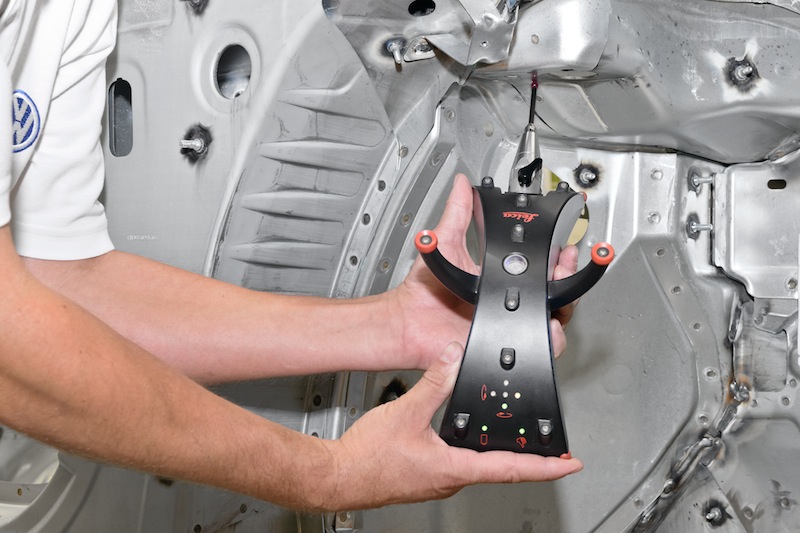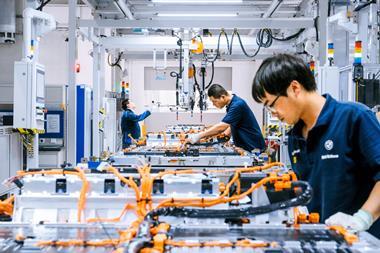
Michael Lettau, product manager laser trackers at Hexagon Metrology, explains how ultra-portable high-speed laser tracker technology has developed to produce the multipurpose inspection tools that are driving better productivity in the automotive industry
 With global demand continuing to rise, automotive manufacturers face a continuous challenge to enhance their productivity. The need to maintain high quality standards and carefully manage costs, while still delivering the heavily customised vehicles the market demands, accentuates the competitive pressure of an already crowded industry sector.
With global demand continuing to rise, automotive manufacturers face a continuous challenge to enhance their productivity. The need to maintain high quality standards and carefully manage costs, while still delivering the heavily customised vehicles the market demands, accentuates the competitive pressure of an already crowded industry sector.
Creating more flexible production environments to increase agility and responsiveness can help to alleviate these pressures, and the key to this is data. Data-driven manufacturing processes use state-of-the-art metrology equipment to gather data from multiple points within production. This data can be processed into actionable information to inform decision making, achieving the agility required to move ahead of the competition.
As a result, dimensional inspection can no longer be considered an end-of-line quality-checking process. New technologies allow manufacturers to meet some of their main challenges head on, changing end-of-line checks into along-the-line or even in-the-line quality inspection. They can actively improve the quality of production processes, for example through machine guidance or robotic assembly systems. Realistically, investment in equipment like this is becoming essential to successful process modernisation. But to make such investment pay off, manufacturers must ensure that they select the right tools for the job. In the new Leica Absolute Tracker AT960 laser tracker system, Hexagon Metrology has developed a multipurpose portable coordinate measuring machine (CMM) with the potential to improve processes across many aspects of automotive production.
From cutting-edge technology to a practical tool
Laser trackers have been on the market for around a quarter of a century now. Initially written off as expensive and lacking a clear area of application, the technology has stood the test of time and become an indispensable metrology device for thousands of manufacturing companies. Ideal for measuring medium to large parts and offering a flexible solution for large-scale inspection and assembly applications, laser trackers have found a home in the metrology arsenal for all kinds of industries and sectors.
Part of the reason behind the adoption of this technology is the rapid development it has shown since launch. In simple terms, a laser tracker is a portable CMM which uses a laser beam to measure accurately in a spherical volume – in the case of the new AT960, a measurement volume of up to 120m (Ø). Essentially, a laser tracker measures two angles and one distance to calculate a precise coordinate. A target is positioned at a point to be measured, and the tracker emits a laser beam towards it. The target reflects this light back towards the tracker station, enabling the system to reference the location of the target.
Since the first laser trackers were launched in the early 1990s, Hexagon Metrology’s Leica Absolute Tracker range has introduced a number of innovations to make its systems more practical and easy to use. These include the world’s first absolute interferometer and the PowerLock active vision system. But, for the automotive industry, perhaps the most significant development has been six degrees of freedom (6DoF) trackers like the AT960. While the original laser tracker systems were only capable of measuring to reflectors, the development of 6DoF tracker technology opened up the potential for probing, scanning and machine control applications. It is this versatility, alongside their portable nature, that makes laser tracker systems such a useful tool for vehicle producers.
The advantages of portability, speed & accuracy

Whereas previously a 6DoF laser tracker required several accessories to operate at its maximum potential, the AT960’s all-in-one design incorporates all the equipment required to measure to a reflector, Leica T-Probe, Leica T-Scan or Leica T-Mac in one ultra-portable and robust IP54-certified unit. With a sensor weight of less than 14kg, the entire system fits into a single flight case for easy relocation. Built-in wireless and battery function options minimise set-up times so the device can be transported easily, unpacked quickly and powered up in minutes to measure in any location.
While for factory-based applications portability may not seem an immediate priority, it is surprising how large an impact it can have on how a device is used. The great advantage of portable CMMs is that they can be moved to the part, instead of the part needing to be relocated to the quality room. With the AT960’s excellent portability, not only does its small footprint save valuable workspace on the shopfloor, but it also allows a range of flexible mounting options including inclined and inverted functionality. It is easily relocated by a single operator, and the speed of set-up between locations means the tracker can be moved from one process function to another – whenever and wherever it is required. With equipment uptime and productivity both important considerations in assessing return on investment, the AT960’s portability makes it an increasingly attractive proposition.
As industry has moved towards data-driven manufacturing, the role of metrology has shifted. Whereas previously quality inspections were something of a burden which ate up resources with limited returns, the equipment available today makes this process more proactive, and the ability to gather data quickly and easily is at the centre of this change. Driven by Hexagon Metrology’s patented and proven Leica Absolute Interferometer (AIFM) and PowerLock technologies, the AT960 delivers on this promise with high-speed dynamics and user-friendly operating functions.
"This new generation of laser tracker offers a balance of practicality and user-friendliness which will enable automotive manufacturers to build increasingly agile factory environments in years to come"
– Michael Lettau, Hexagon Metrology
The third-generation PowerLock active vision technology provides intelligent automatic target location to instantly re-establish an interrupted beam and continue the measurement with no user intervention required, while the AIFM brings together the accuracy of an absolute distance meter and the speed of an interferometer to measure a moving target with the fastest speed possible. In combination with a true real-time operating system, the AIFM and PowerLock allow the AT960 to continue measuring with a maximum distance uncertainty of just 10μm after beam interruption and deliver a data rate of 1,000 points per second.
With its absolute distancing capabilities, the AIFM is also the critical component behind the accuracy of the AT960 across several different inspection methods. The built-in variozoom technology provides the 6DoF capability required for Leica T-Product compatibility, giving the system its probing, scanning and machine control options as well as traditional reflector measurements. This flexible functionality is not just for show – it is a key aspect of the agility that the AT960 offers.
The right way to measure, every time
Any good piece of equipment should help to complete a task quickly, not slow down or delay the process. But it has to be the right equipment for the task. Almost any manufacturing process can be disrupted by applying the wrong tools, and the metrology aspect of industrial manufacturing is no different. With their ability to acquire data very quickly, the laser trackers of the past were sometimes pushed beyond their intended functionality, opening up the possibility of questionable results.
One of the major flaws in the earliest laser trackers was that the only way to gather high-density point cloud data was to scrub the reflector over a surface. Inaccurate to say the least, this method also risks damaging both the reflector and the object surface. Imagine the potential damage that could be caused in recording the dimensions of bodywork for a high-value sports car with this technique. With the four methods of measurement that the AT960 offers, this simply isn’t an issue.
In a scenario like this, the AT960’s Leica T-Product compatibility means that operators could simply switch from reflector measurements to the non-contact laser scanning solution to record the surface contours at a rate of over 200,000 points per second, or use a probe for hidden points. With PowerLock to automatically locate the target, switching between inspection methods is easy and efficient. And the 6DoF functionality also enables the tracker to power a range of automated applications from simple inspection programs to complex robotic guidance systems.
Laser trackers in the automotive world
Of course, industrial robots are a familiar sight in automotive factories. Vehicle manufacturers were the original adopters of automated production equipment and their use will only increase as robots become more accurate. By their nature, robots are very repeatable, but their absolute accuracy is less strong and they remain susceptible to the influence of external factors like temperature.
While robotic guidance is certainly an exciting prospect, the current applications of laser tracker technology for vehicle manufacturing are extraordinarily varied and begin at a much more basic level. The portable nature of trackers enables them to be brought to the production line to inspect parts, cutting the logistical cost and time spent on inspections. Similarly, trackers can be used to check tooling set-ups and alignment in the line, helping to ensure the accuracy of operations while causing minimal disruption to the process.
The data-rich point clouds created by laser scanning solutions enable fast inspection of large surfaces, whether they are regular or freeform geometries. Operated manually for spot inspections or mounted on a robot for faster, more efficient inspections of large areas, this method is ideal for body-in-white and closure part inspection. Extending this application, some manufacturers utilise the same techniques for their flush and gap checks, or even to run virtual assembly programs. With automotive manufacturers increasingly globalised and parts being produced on different lines, in different plants or by different subcontractors, virtual assembly can be a real advantage in avoiding costly part-mating issues.
Production and assembly is not the only area of automotive development to benefit from laser tracker technology. Quick and accurate measurements are also essential in vehicle development. Part testing and subsequent design modifications rely on understanding the behaviour of components during trials and taking a tracker into testing centres can add an immense amount of information in this area.
Some manufacturers have even installed laser tracker mountings within wind tunnels to enable consistent inspection of parts between aerodynamic tests or single-point monitoring under ‘wind on’ test conditions – a specialised application where the high-speed dynamics of a device like the AT960 really come into their own. Laser tracker technology can also be used to support reverse engineering and rapid prototyping.
The equipment of the future
The rate of development in laser tracker technology over the last 25 years has been impressive. In the AT960, Hexagon Metrology has been able to leverage mature technologies alongside new developments to offer absolute portability, absolute speed and absolute accuracy. But just as importantly, this new generation of laser tracker offers a balance of practicality and user-friendliness which will enable automotive manufacturers to request or develop new and ever-more sophisticated ways to utilise and apply these three core traits to their specific needs and build increasingly agile factory environments in years to come.






































